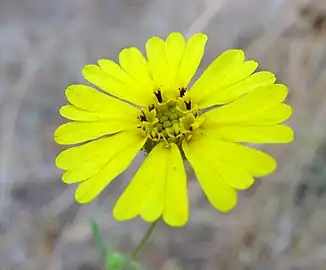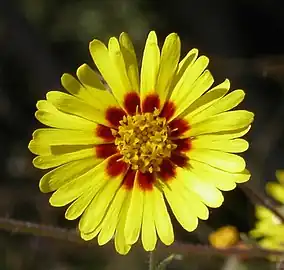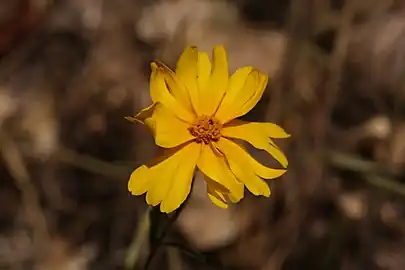Madia elegans
Madia elegans is an annual herbaceous plant species in the family Asteraceae. It is generally known as the common madia, but there are several subspecies known by various common names.[1]
| Madia elegans | |
|---|---|
 | |
| Long-horned bee on flower head | |
| Scientific classification | |
| Kingdom: | Plantae |
| Clade: | Tracheophytes |
| Clade: | Angiosperms |
| Clade: | Eudicots |
| Clade: | Asterids |
| Order: | Asterales |
| Family: | Asteraceae |
| Genus: | Madia |
| Species: | M. elegans |
| Binomial name | |
| Madia elegans | |
Description
Madia elegans is covered with short, stiff hairs. Glands are borne on stalks, especially near the flowers.[1] The showy flower varies in appearance across subspecies and even within subspecies. The leaves grow to 20 centimetres (8 inches) in length.[2] Blooming between April and October, several strongly scented, uncrowded, bright yellow daisy-like flower heads grow at the end of a slender green stem, each typically 3–5 centimetres (1+1⁄4–2 inches) wide.[2][3] The flower has numerous thin ray flowers, which close at night,[2] and several central disk flowers. It may be solid lemon yellow or have a maroon center.[2] Its fruits are achenes.
 Growth with maroon-centered flower heads; Oregon
Growth with maroon-centered flower heads; Oregon Stems and flowers; Santa Cruz Mountains, California
Stems and flowers; Santa Cruz Mountains, California Flower head; Santa Monica Mountains, California
Flower head; Santa Monica Mountains, California Flower head with maroon center; San Joaquin County, California
Flower head with maroon center; San Joaquin County, California Flower head; Josephine County, Oregon
Flower head; Josephine County, Oregon
Taxonomy
Subspecies
- Madia elegans densifolia - showy tarweed
- Madia elegans elegans - common madia
- Madia elegans vernalis - spring madia
- Madia elegans wheeleri - Wheeler's tarweed
Etymology
The foliage of species in the genus has sticky hairs, hence the common name tarweed.[2]
Distribution and habitat
The plant is native to western North America from south-central Washington state to northern Baja California.[3][1][4][5] It may be found in dry open forest, disturbed areas and grasslands from low to high elevations.[3]
Uses
The achenes were historically used as food by Native Americans, including the Pomo and Miwok, who baked them or ground them into flour.
References
- Giblin, David, ed. (2015). "Madia elegans". WTU Herbarium Image Collection. Burke Museum, University of Washington. Retrieved 2015-01-17.
- Spellenberg, Richard (2001) [1979]. National Audubon Society Field Guide to North American Wildflowers: Western Region (rev ed.). Knopf. p. 387. ISBN 978-0-375-40233-3.
- Sullivan, Steven. K. (2015). "Madia elegans". Wildflower Search. Retrieved 2015-01-17.
- "Madia elegans". PLANTS Database. United States Department of Agriculture; Natural Resources Conservation Service. 2015. Retrieved 2015-01-17.
- Hogan, C. Michael (curator). "Madia elegans". Encyclopedia of Life. Retrieved 2015-01-18.
External links
 Media related to Madia elegans at Wikimedia Commons
Media related to Madia elegans at Wikimedia Commons Data related to Madia elegans at Wikispecies
Data related to Madia elegans at Wikispecies- Jepson Manual Treatment: Madia elegans
- U. of Michigan Ethnobotany: Madia elegans
- Madia elegans — CalPhotos gallery